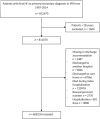A nationwide study of temporal trends of cause-specific hospital readmissions in patients with heart failure
- PMID: 37519022
- PMCID: PMC10567653
- DOI: 10.1002/ehf2.14474
A nationwide study of temporal trends of cause-specific hospital readmissions in patients with heart failure
Abstract
Aims: The impact of hospital readmissions on the outcomes of heart failure (HF) patients is well known. However, data on temporal trends of cause-specific hospital readmissions in these patients are limited.
Methods and results: From 1987 to 2014, we identified and followed up for 1 year 608 135 patients ≥18 years hospitalized with HF according to the International Classification of Diseases (ICD) 9 and 10 from the National Inpatient Register. Readmissions for cardiovascular (CVD) and non-CVD causes and co-morbidities were defined according to ICD-9 and ICD-10 codes. We analysed trends in the incidence rate of readmissions, the median time to the first rehospitalization, and the time to readmission, stratified by sex, age groups and cause of rehospitalization using linear regression. During our study, 1 year all-cause mortality decreased (β = -4.93, P < 0.0001), but the incidence rate of readmissions per 1000 person-years remained unchanged. The readmission rate for CVD causes decreased; in contrast, the readmission rate increased across all age and sex groups for non-CVD causes. Analysing the patients by study periods (1987-1997, 1998-2007 and 2008-2014), CVD and non-CVD co-morbidities had a statistically significant increasing trend (P < 0.001). The median time in hospital decreased and the median time to the first readmission were almost unchanged.
Conclusions: Contrary to a declining mortality rate, the incidence rate of readmissions saw no change, possibly because of divergent trends in cause-specific readmissions. An increasing rate of readmissions for non-CVD causes underscores the importance of optimising multimorbidity management to reduce the risk of readmissions in patients with HF.
Keywords: Heart failure; Incidence rate; Rehospitalizations.
© 2023 The Authors. ESC Heart Failure published by John Wiley & Sons Ltd on behalf of European Society of Cardiology.
Conflict of interest statement
None declared.
Figures




Similar articles
-
Temporal trends in cause-specific readmissions and their risk factors in heart failure patients in Sweden.Int J Cardiol. 2020 May 1;306:116-122. doi: 10.1016/j.ijcard.2020.02.048. Epub 2020 Feb 22. Int J Cardiol. 2020. PMID: 32145935
-
Trends, Predictors, and Outcomes of 30-Day Readmission With Heart Failure After Transcatheter Aortic Valve Replacement: Insights From the US Nationwide Readmission Database.J Am Heart Assoc. 2022 Aug 16;11(16):e024890. doi: 10.1161/JAHA.121.024890. Epub 2022 Aug 5. J Am Heart Assoc. 2022. PMID: 35929464 Free PMC article.
-
Trends in 30-day readmissions following hospitalisation for heart failure by sex, socioeconomic status and ethnicity.EClinicalMedicine. 2021 Jul 14;38:101008. doi: 10.1016/j.eclinm.2021.101008. eCollection 2021 Aug. EClinicalMedicine. 2021. PMID: 34308315 Free PMC article.
-
Trends in Cause-Specific Outcomes Among Individuals With Type 2 Diabetes and Heart Failure in the United Kingdom, 1998-2017.JAMA Netw Open. 2019 Dec 2;2(12):e1916447. doi: 10.1001/jamanetworkopen.2019.16447. JAMA Netw Open. 2019. PMID: 31790564 Free PMC article.
-
Temporal Trends and Predictors of Thirty-Day Readmissions and Emergency Department Visits Following Total Knee Arthroplasty in Ontario Between 2003 and 2016.J Arthroplasty. 2020 Feb;35(2):364-370. doi: 10.1016/j.arth.2019.09.015. Epub 2019 Sep 14. J Arthroplasty. 2020. PMID: 31732370 Review.
References
-
- Zarrinkoub R, Wettermark B, Wandell P, Mejhert M, Szulkin R, Ljunggren G, Kahan T. The epidemiology of heart failure, based on data for 2.1 million inhabitants in Sweden. Eur J Heart Fail. 2013; 15: 995–1002. - PubMed
-
- Boman K, Lindmark K, Stålhammar J, Olofsson M, Costa‐Scharplatz M, Fonseca AF, Johansson S, Heller V, Törnblom M, Wikström G. Healthcare resource utilisation and costs associated with a heart failure diagnosis: a retrospective, population‐based cohort study in Sweden. BMJ Open. 2021; 11: e053806. - PMC - PubMed
Grants and funding
- 2015-0438/Swedish state under an agreement between the Swedish government and the County Councils Concerning Economic Support of Research and Education of Doctors, the Swedish Heart and Lung Foundation
- 2018-0589/Swedish state under an agreement between the Swedish government and the County Councils Concerning Economic Support of Research and Education of Doctors, the Swedish Heart and Lung Foundation
- 2021-0345/Swedish state under an agreement between the Swedish government and the County Councils Concerning Economic Support of Research and Education of Doctors, the Swedish Heart and Lung Foundation
- 2019-00193/Swedish Research Council (VRREG) Framework
- 2018-02527/Swedish Research Council
LinkOut - more resources
Full Text Sources
Research Materials
Miscellaneous

